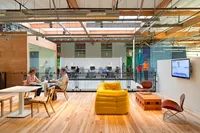Google launches healthy building materials Tool to change an industry

At Google, we are committed to creating the healthiest work environment possible and using building products that promote human and environmental health and transparency. Inspired by this challenge, we have been making great strides toward giving everyone access to the information needed to understand human and environmental impacts of materials so we can make healthy decisions backed by science. This means you can know all the ingredients of every product in your environment──from the chair you are sitting in, to the paint you purchased for your living room──just like the nutrition labels on the food you buy at your neighborhood grocery store.
While a robust framework for gathering product information is important; it is also critical to build processes and tools that can be used to select and specify healthy materials. Embracing this challenge to serve the scale at which Google operates resulted in the creation of Portico, an online web application that Google developed in partnership with non-profit partner Healthy Building Network (HBN).
Since 2015, Google has been testing Portico on internal design and construction projects and using it to establish and communicate the company’s values and priorities around human health, informing decisions that meet Google’s healthy materials criteria, and product scoring based on reliable and transparent manufacturer supplied data. To-date, we have used Portico on over 195 projects in 20 countries and over 1,500 project team members and 5,000 manufacturers participating, contributing to a growing database of over 2,500 products that have satisfied Google’s healthy material requirements.
Based on the successes from this internal testing, Google and HBN have announced today the expansion of Portico with the addition of four new partners: Harvard University, Perkins + Will, The Durst Organization and HomeFree Affordable Housing (an HBN-led affordable housing consortium). As industry thought leaders, this group of organizations have adopted Portico as a critical tool to support their mission and commitment for creating a healthy built environment.
Portico was created to bridge the gap in the marketplace with a platform that combines a product database and collaborative workflow tools, built on an open source mode. The goal was to create a place where the information could be gathered in a sharable format that could then be searched and interpreted by anyone using the tool.
Furthermore, the tool itself can host a diverse set of applications that are built based on the needs of its end users. This is powerful. With Portico, instead of being limited by how the data can be used and shared, the tool offers an opportunity to expand the boundaries of the problems that data can solve, making it possible for the building industry community to ask more audacious questions and solve more complex problems than any individual or organization alone.
Over the next year, Google will be working closely with these partners to continue evolving and expanding Portico so it is able to solve critical problems beyond the needs of a set of organizations. By leveraging the power of technology to continue to optimize and develop the platform, Portico can be used at the ecosystem scale. With this incremental step of opening Portico to a group of partners other than Google, we hope to build a future where individuals and organizations of any size are able to have open access to information that is essential to creating environments that are optimized for human and environmental health. This bright future is not only a win for Google but for many generations to come.







